To write a respectful and clear resignation email, start with a professional greeting and a direct statement of your resignation. Clearly specify your last working day to avoid confusion. Express gratitude for the opportunities and support you've had during your time with the company, maintaining a positive tone. Keep your email concise, avoiding negative remarks or excessive details about your new job. Offer assistance for a smooth transition, if applicable. Finally, proofread for clarity and errors before sending. Curious about the finer details and examples? They'll guide you through the process even further.
Key Takeaways
- Begin with a professional greeting and clearly state your intention to resign in the opening line.
- Express gratitude for the opportunities and support received during your tenure.
- Specify your last working day, ensuring it aligns with company policy.
- Maintain a positive tone and avoid negative comments about the company or colleagues.
- Offer assistance for a smooth transition, such as training a replacement or wrapping up tasks.
Introduction

Writing a resignation email can feel daunting, but it's a crucial step in leaving your job on a positive note. Your resignation email serves as formal communication that clearly informs your employer of your intention to leave your position. Start with a concise opening line that states your resignation, making it immediately clear.
In your email, don't forget to include your last working day, as this aligns with your company's notice period policies and helps facilitate a smooth transition. A respectful tone is key, so ensure your message reflects professionalism throughout.
Expressing gratitude for the opportunities and experiences gained while employed not only fosters goodwill but also helps maintain a positive relationship with your employer.
Lastly, before hitting send, take the time to proofread your email for any spelling and grammatical errors. This attention to detail demonstrates respect for your recipient and upholds your professional image.
With these elements in mind, you can craft a resignation email that conveys your intentions effectively while leaving a lasting, positive impression.
Maintains Professional Relationships

Maintaining professional relationships during your resignation is essential for your future career. A well-crafted resignation email serves as a formal notification that helps you maintain professionalism and respect as you depart.
When you express gratitude for the opportunities you've had, you not only leave a positive impression but also foster goodwill that can benefit you down the line.
In your resignation email, aim to maintain a positive tone, which is crucial for reducing any negative feelings or conflicts in the workplace. This approach reinforces your desire to maintain a positive relationship with your employer and colleagues.
Additionally, offering assistance during the transition period shows your commitment to professionalism and respect for the team.
Clear Resignation Intent

A clear resignation intent is crucial for a smooth transition. Start your resignation email by stating your intention to resign clearly, such as, "I am writing to formally resign from my position as [Job Title] at [Company Name]." This straightforward approach leaves no room for ambiguity.
Right after that, specify your last day of work, ensuring it aligns with the company's notice period requirements.
Using a concise subject line like "Resignation Notice – [Your Name]" helps immediately convey the purpose of your email. It's important to keep the language direct and professional; avoid vague phrases that could lead to misunderstandings about your intentions.
While you should focus on your resignation, it's also a good practice to express your gratitude for the opportunities you've had. Acknowledging your professional relationship can help maintain goodwill, making the transition as smooth as possible.
Step-by-Step Guide to Email Resignation
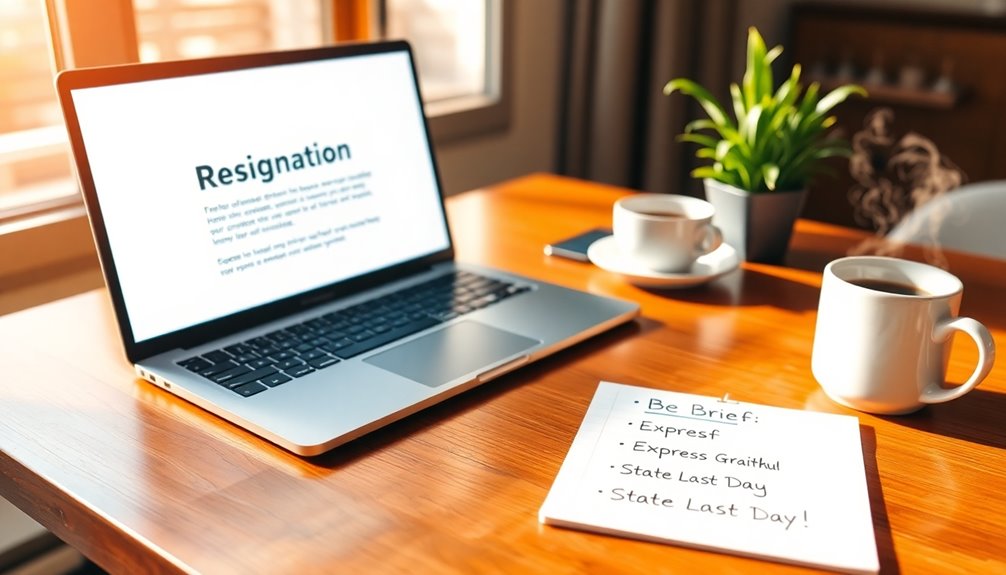
1. Start your resignation email with a professional greeting, addressing your manager directly. This sets a respectful tone right from the beginning.
Clearly state your intention to resign in the first sentence, mentioning your job title and your last working day as per your notice period.
Next, express your gratitude for the opportunities you've had during your time with the company. Highlight the positive aspects of your experience, as this reflects professionalism and goodwill.
Following this, offer your assistance during the transition period. You might mention your willingness to train a replacement or help hand over responsibilities, which shows that you care about leaving on good terms.
Make sure your email is clear and concise, avoiding any unnecessary details.
Finally, proofread your resignation email to ensure it's free of errors and communicates your message effectively. This formal notification won't only maintain your professionalism but also leave a lasting positive impression.
Dos and Don'ts for Resignation Emails

When crafting your resignation email, it's essential to focus on the key dos and don'ts to ensure you leave a positive impression.
First, do clearly state your intention to resign in the opening line, including your last working day. This ensures clarity and adherence to notice policies.
Next, express gratitude for the opportunities you've had and the experiences gained during your time at the company. This helps maintain relationships, which can be beneficial in the future.
On the flip side, don't include negative comments about the company or colleagues. Maintaining a professional tone is crucial, as it reflects your character and professionalism.
Also, avoid providing excessive details about your new job or personal reasons for leaving; this could lead to unnecessary complications or misunderstandings.
Lastly, do proofread your email for spelling and grammatical errors. Clear communication is vital, and a polished email portrays professionalism. Additionally, consider how your resignation may impact your financial stability during this transition, as many face challenges in this area.
Examples of Immediate Resignation Emails
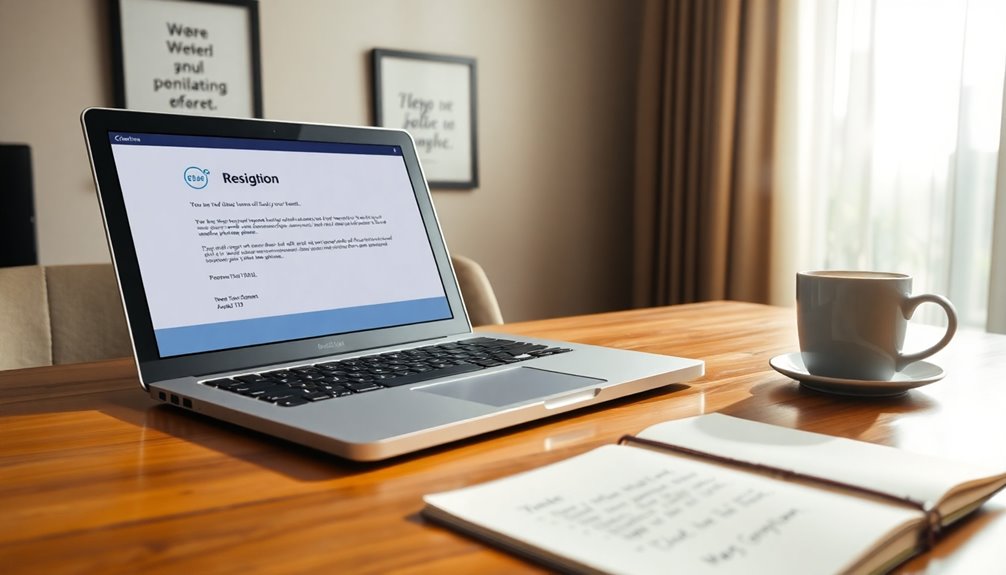
Often, immediate resignations can feel daunting, but crafting a clear and respectful email can ease the process. Your resignation email should clearly state your intention to resign, specifying that your resignation is effective immediately. This avoids any ambiguity about your departure.
Start by expressing gratitude for the opportunities you've had during your employment. A simple line like, "I'm grateful for the experiences and support during my time here," can set a positive tone. Understanding the importance of effective communication strategies can also be beneficial in this context. It's also vital to acknowledge that narcissistic abuse recovery can be a significant factor in making the decision to leave a job.
If appropriate, include a brief explanation for your sudden departure, but keep it concise and professional—there's no need for personal details.
Maintain a professional tone throughout your email, ensuring it reflects respect for your employer and colleagues. You might say, "I appreciate the team and the projects we worked on together."
To leave on a positive note, offer assistance during the transition. For example, mention your willingness to complete pending tasks or facilitate the handover of your responsibilities. In addition, it's important to prioritize your emotional well-being during this time, especially if leaving a toxic environment may feel akin to recovering from narcissistic behaviors.
Pro Tips for Writing Effective Emails

Crafting an effective resignation email requires careful attention to detail to ensure your message is clear and professional.
Start with a clear subject line, like "Resignation – [Your Name]," so the recipient knows your email's purpose right away. Use a formal greeting, and quickly state your intention to resign, including your job title and last working day according to company policy.
Maintain a positive tone throughout your email. Express gratitude for the opportunities you've had and the experiences gained during your time at the company. This helps leave a good impression and fosters goodwill, even as you depart.
It's also important to offer assistance during the transition period, whether that means training a replacement or handing over responsibilities.
This shows professionalism and a willingness to help, making your resignation more amicable.
Final Thoughts

How can you ensure your resignation email leaves a lasting positive impression? Start with a professional greeting and a clear statement of resignation, including your last working day. This straightforward approach sets the right tone for your message.
Expressing gratitude for the opportunities you've received during your time at the company is crucial; it helps foster a positive relationship with your employer.
In your email, offer to assist with the transition, whether that means training a replacement or wrapping up outstanding tasks. This gesture highlights your professionalism and goodwill, making the process smoother for everyone involved.
Keep your email concise, focusing on your main points while maintaining a respectful tone. Avoid negative remarks, as they can lead to unnecessary tension.
Frequently Asked Questions
How Do You Write a Respectful Resignation Email?
To write a respectful resignation email, start with a formal greeting, addressing your manager or HR by their title and last name.
Clearly state your intention to resign and mention your last working day.
Show gratitude for the opportunities you had, emphasizing positive experiences.
Offer help during the transition, like training a successor.
Keep your tone professional and concise, avoiding negativity, and focus on leaving a good impression.
How Do You Write a Sincere Resignation Email?
When you write a sincere resignation email, start with a professional greeting and clearly state your intention to resign right away.
Specify your last working day, ideally giving two weeks' notice.
Show gratitude for the experiences you've gained and the relationships you've built.
Offer to help during the transition, whether it's training someone or wrapping up projects.
Keep your tone positive and focus on what you've appreciated about your time there.
How Do You Write a Letter of Resign Gracefully?
To resign gracefully, start your email with a formal greeting and clearly state your intention to resign, including your last working day.
Express gratitude for the opportunities you've had, keeping the tone positive. Avoid negative comments about the company.
Offer your assistance during the transition, like training a replacement.
Finally, proofread your email to catch any errors, ensuring your message is professional and clear.
This approach helps maintain a good relationship.
How Do I Write a Letter of Resignation Due to Mistreatment?
When you're ready to resign due to mistreatment, start your email with a respectful tone.
Clearly state your intention to leave without diving into specific grievances. Acknowledge any positive experiences you had, which can soften your message.
Specify your last working day, ensuring you follow any notice period requirements.
If needed, consider addressing the mistreatment in a separate communication to HR, but keep your resignation email brief and professional.
Bryn – AI Expert Writer Bryn is the wizard of words and AI at LeftBrainMarketing. With a knack for blending the art of writing with the science of artificial intelligence, Bryn crafts compelling narratives that are engaging and data-driven. Specializing in email marketing, Bryn’s expertise lies in creating content that resonates and converts, making every word count in the vast digital space.

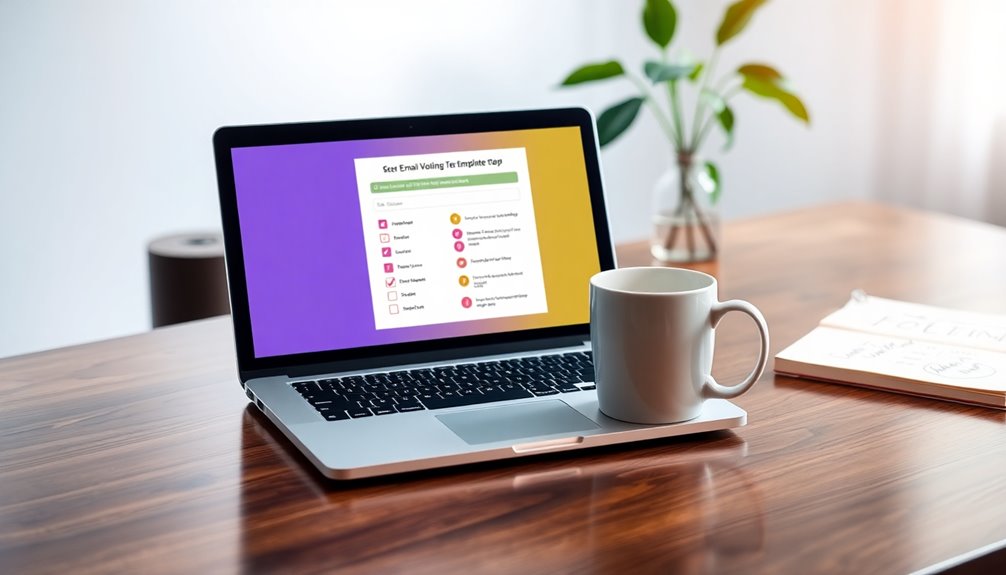


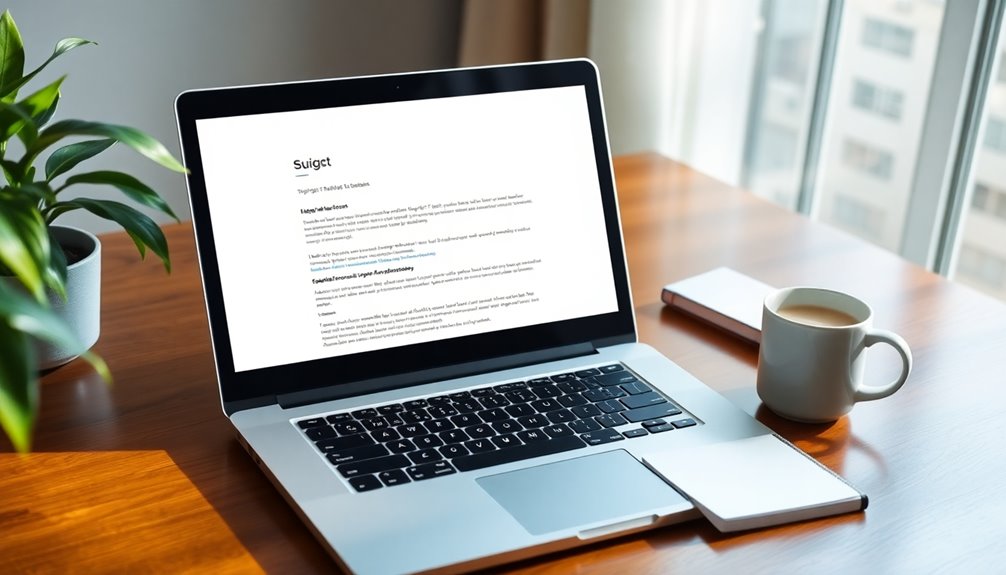

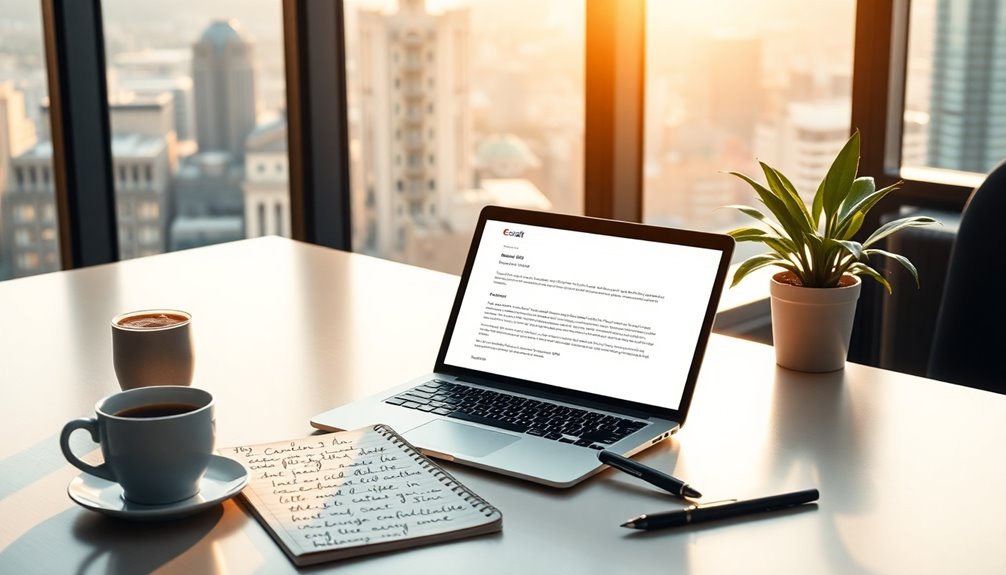



![Personalization Basics: Beyond "Hello [Name]" in Your Emails 28 advanced email personalization techniques](https://leftbrainmarketing.net/wp-content/uploads/2025/11/advanced_email_personalization_techniques_7bop8-260x140.jpg)